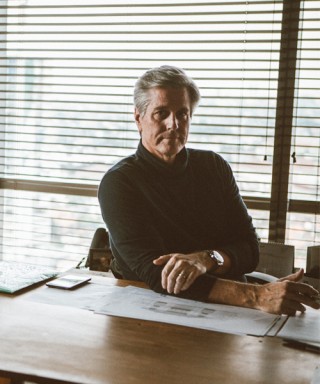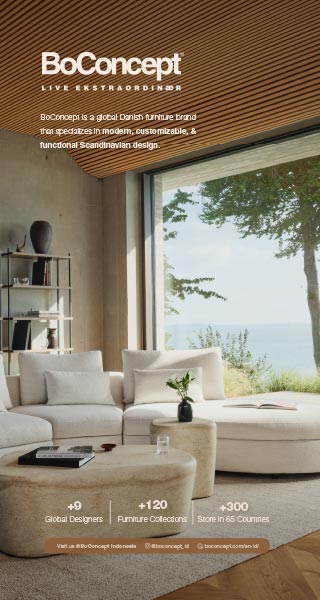
THE SHAKERS: A WORLD IN THE MAKING BY VITRA DESIGN MUSEUM
Published by Sugar & Cream, Friday 25 April 2025
Images courtesy of Vitra Design Museum
07 June 2025 – 28 September 2025 at Vitra Design Museum, Weil am Rhein
How did an 18th-century American free church inspire generations of artists, architects, and designers around the world? The Shakers were a religious group for whom design and architecture were an expression of beliefs surrounding community, labour, and social equality. The new exhibition, »The Shakers: A World in the Making« examines how this resulted in meticulously crafted furniture and vernacular architecture that continue to resonate centuries later. Bringing together a wide range of Shaker furniture, architectural elements, tools, and commercial goods, paired with newly commissioned works by contemporary artists and designers, »The Shakers: A World in the Making« reveals the complex social, material, and spiritual context that created the “Shaker style”, and what possibilities its values offer today. The exhibition is organised by the Vitra Design Museum, the Milwaukee Art Museum, the Institute of Contemporary Art Philadelphia, and the Wüstenrot Foundation in collaboration with Shaker Museum.
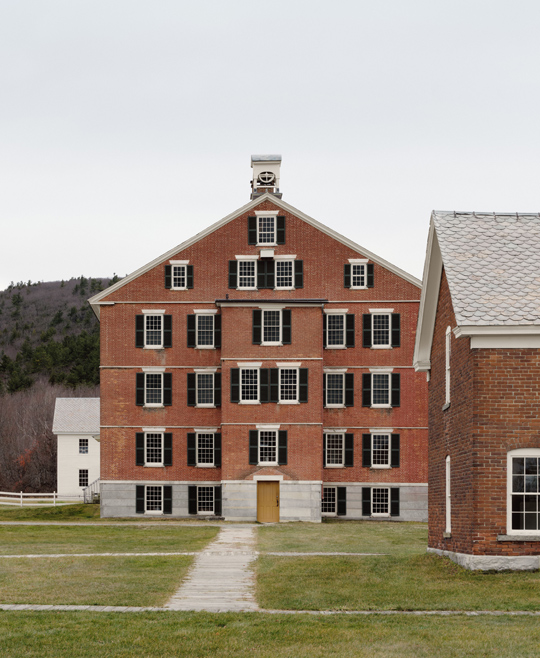
Founded in England in the late 18th century, the Shakers emigrated to the American colonies in 1774, where they established eighteen distinct communities from Kentucky to Maine. Within these communities, the Shakers created furniture, domestic objects, and architecture that were soon hailed for their radical simplicity, as well as their innovative use of standardization and serial production. The group’s contributions to design and architecture are still celebrated to this day but are often interpreted purely in terms of their aesthetic. Instead, “The Shakers: A World in the Making” explores how Shaker design was deeply rooted in the Shakers’ religious practice of worship and labour. Designed by Milan-based studio Formafantasma, the exhibition brings together more than 150 original objects, most of which have been loaned from the world-leading collection of the Shaker Museum in Chatham, New York.
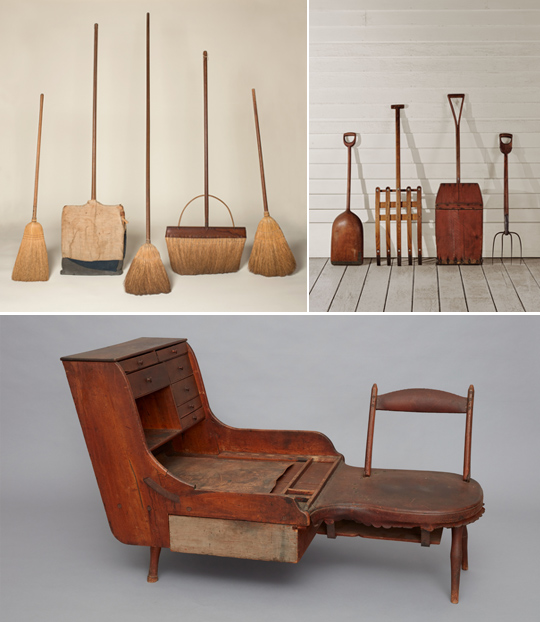
In addition to historic works, the exhibition also includes new research and commissions from seven international contemporary designers and artists. These commissioned works engage the Shaker artifacts in dialogue, with each artist approaching the Shakers and their material culture from a unique and personal perspective – a link between past and present that allows visitors to forge new connections with one of history’s most compelling experiments in alternative communal living. Through this mixture of contemporary and historical material, the exhibition explores the enduring resonances of the Shakers in the 21st century, including topics such as gender, inclusion, and sustainability. »The Shakers: A World in the Making« challenges the conventional narrative that surrounds Shaker design and instead grounds it within the broader contexts that shaped it.
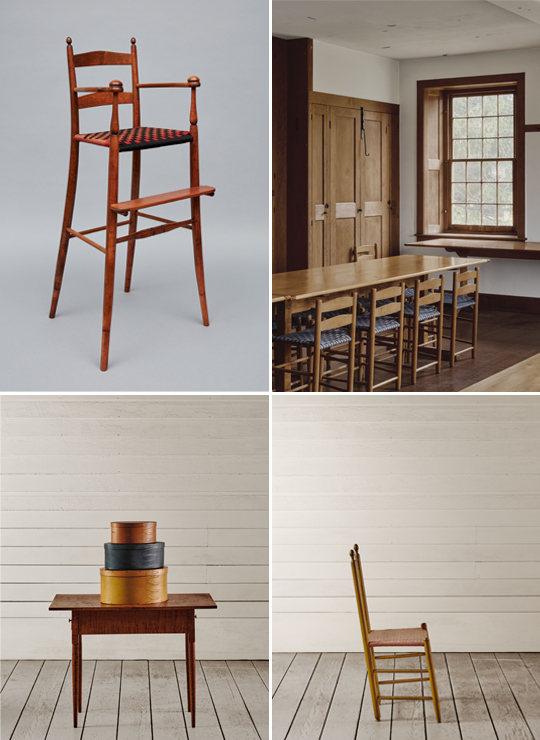
The exhibition is structured through four thematic sections, all of which are named after quotes from members of the Shaker community.

Presented by Zipblind
The first,»The Place Just Right«, provides an introduction to the worldview and social structures that defined Shaker life. Historic and contemporary photography of Shaker architecture is paired with objects such as a Shaker dwelling staircase and a four-metre-long bench to reveal the material realities of their communal and sex-segregated, celibate living. Meanwhile, a radio from the Canterbury Shaker community shows how the group welcomed external innovations and technologies despite their retreat from secular society. This emphasis on sound is carried through to objects that examine the most famous outward expression of Shaker belief: the worshipful dance for which they gained the nickname »Shakers« . A metronome, piano-violin, and hymn book all examine Shaker music and dance, which is a theme continued in a video compilation of »POWER«, a dance piece from artist and choreographer Reggie Wilson that considers the legacy of Shaker dance and its overlap with African-American dance practices and music traditions.
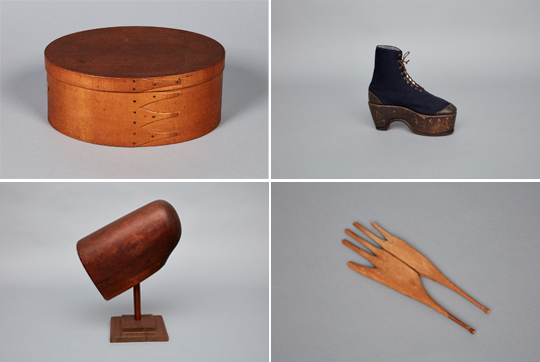
The second space, »When We Find a Good Thing, We Stick To It«, focuses on the material culture of Shaker communities, revealing how their religious beliefs forged the »Shaker style« that remains influential to this day. Garments and furniture such as cabinets, chests of drawers, and sewing desks highlight the community’s instinct toward order and structure, as codified in their 1821 and 1845 Millennial Laws. Many of these same forces are apparent in a selection of the community’s chairs, which are noteworthy for their standardisation, utility, and scope for customisation. The relationship between the Shakers’ drive towards codification, and its potential to nevertheless allow for individual interpretation, evolution, and even religious heresy, is explored in a commission from contemporary artist Kameelah Janan Rasheed – a series of abstracted glyphs that draw on the 19th-century writings of Mother Rebecca Cox Jackson, a Black Shaker Eldress and founder of the only Shaker community established within a city.
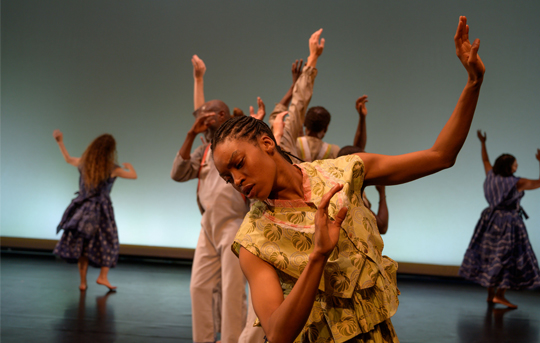
»Every Force Evolves a Form«, the third section of the exhibition, examines the seemingly paradoxical interplay between the Shakers’ ambitions to create an insulated society and a design ethos welcoming of change, innovation, and commerce. Shaker household goods, such as their highly optimised oval boxes and fancy goods, were manufactured and sold to support their communities. The space also includes a display of innovative Shaker brooms, work benches, and rudimentary power tools that highlight the community’s openness to new technologies. The Shakers’ unique place in the transition from traditional crafts to modern design is reflected in a commission from designer and artist Christien Meindertsma. An admirer of Shaker crafts, Meindertsma has reinterpreted their basketry tradition as a contemporary prototype for a biodegradable coffin woven from Dutch willow. Meanwhile, Shaker society’s inclusivity, which was considered progressive for its adaptation of surroundings and objects to accommodate physical impairments, is explored by artist Finnegan Shannon. David Hartt’s »The True Artist Helps the World by Revealing Mystic Truths (Tree of Light)« interrogates the rigidity of Shaker life, engaging with their spirituality and history through film.
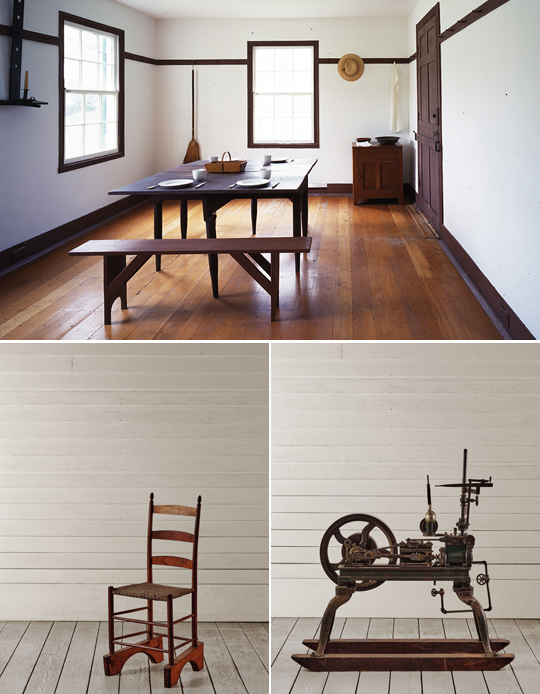
The final section of the exhibition, »I Don’t Want to be Remembered as a Chair«, considers the legacy of the Shaker movement and the contemporary relevance of its community-led creative production. Within its historic exhibits, it presents a series of intricate »gift drawings« from 1830 to 1850, which emerged from divine visions experienced and recorded by Shaker Sisters. The Shaker belief in labour as a form of worship, meanwhile, is reinterpreted by artist and designer Chris Halstrøm through a large-scale embroidered artwork in which the artist understands each stitch as a prayer. As a centrepiece of this section, artist Amie Cunat has created »Meetinghouse 2«, a scaled reinterpretation of a Shaker meetinghouse, the communal dwelling in which Shakers gathered for worship, which can be accessed by visitors and encourages their reflection on spirituality and community.
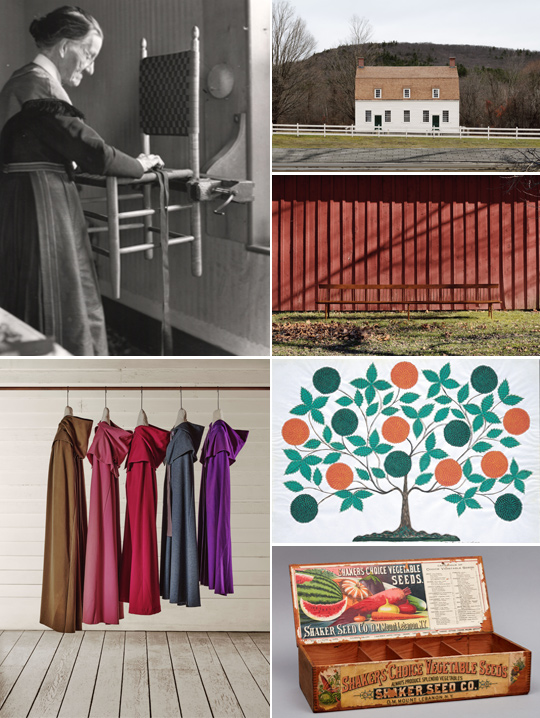
Mateo Kries, Director of the Vitra Design Museum: »Our museum has always had a strong interest in exploring design currents that lay off the beaten track and illustrate the wider cultural, philosophical, and even spiritual context of design. Our furniture collection includes several Shaker pieces, which were part of the inspiration to realise this exhibition. The exhibition itself is the result of a productive transatlantic collaboration that, in light of current political shifts, seems more important than ever.«

Mea Hoffmann, co-curator of the exhibition »’The Shakers: A World in the Making’ looks at the Shaker legacy, both in terms of the group’s design and worldview, from a contemporary perspective, inviting artists and designers to explore what the Shaker world might have to offer us today. The different expertise of each institution involved in the exhibition has resulted in an enriching collaboration that bridges not only an ocean but also connects contemporary artists and designers in a dynamic dialogue that reflects on the enduring relevance of the Shakers.«
The exhibition is guided by a broad range of events and workshops. Following its premiere at the Vitra Design Museum, the exhibition will be presented at the Milwaukee Museum of Art (25 September 2026 – 31 January 2027), the Institute of Contemporary Art in Philadelphia (31 January – 9 August 2026), and in further international museum venues.
 7.38K
30/12/2025
7.38K
30/12/2025
FRAG UNVEILS A NEW CHAPTER IN MATERIAL-DRIVEN DESIGN
in 2025 FRAG unveils a new chapter in material-driven design: a collection that deepens its enduring dialogue with materials.
read more 4.04K
29/12/2025
4.04K
29/12/2025
CHANEL HOLIDAY 2025 — FESTIVE GIFT GUIDE SEASON
CHANEL Holiday 2025 unveils luminous icons and sensorial treasures to brighten this festive season for you!
read more 11.03K
03/12/2025
11.03K
03/12/2025
LIVING DIVANI ILLUMINATES THE FESTIVE SEASON IN SHADES OF DEEP RED AND LUMINOUS SILVER
Living Divani illuminates the festive season in shades of deep red and luminous silver, reimagining its iconic designs with festive radiance.”
read more 10.32K
15/12/2025
10.32K
15/12/2025
CIERRE1972 PRESENTS BELT AND MAC: TWO ARMCHAIRS DEFINED BY CONTEMPORARY ELEGANCE
Cierre1972’s Dynamic Duo, Defined by Contemporary Elegance
read more 81.74K
10/01/2025
81.74K
10/01/2025
W RESIDENCE IN SOUTH JAKARTA BY MICHAEL CHANDRA
Michael Chandra, founder of MNCO Studio Design has created the W Residence with an aesthetically pleasing, practical, and pleasant home from all...
read more 44.47K
11/07/2025
44.47K
11/07/2025
PELUNCURAN PERDANA LEGANO HOME MENGGANDENG AGAM RIADI DI ST REGIS RESIDENCE JAKARTA
Peluncuran perdana LEGANO HOME menggandeng Agam Riadi di St. Regis Residence Jakarta: menyatukan kemewahan dan jiwa dalam sebuah ruang.
read more




